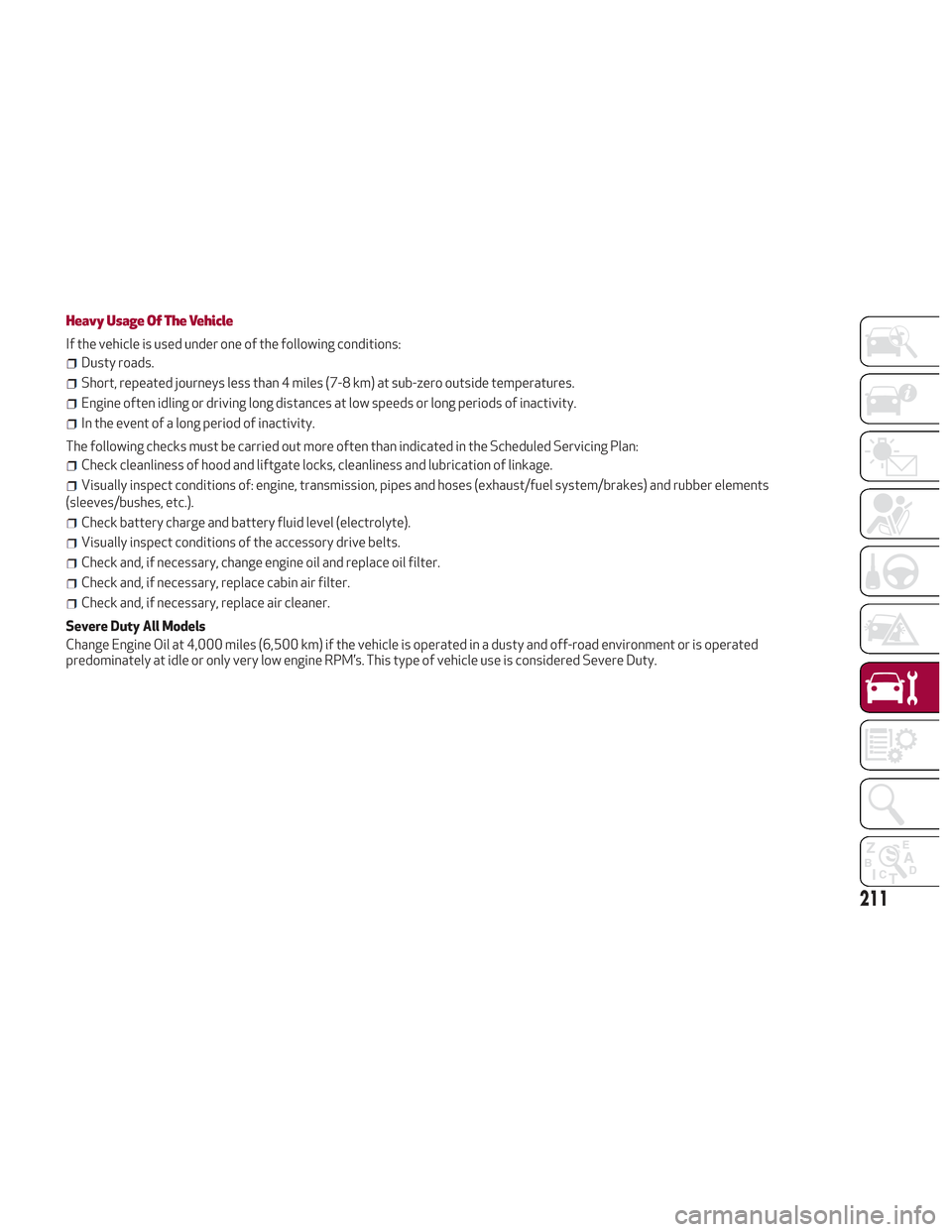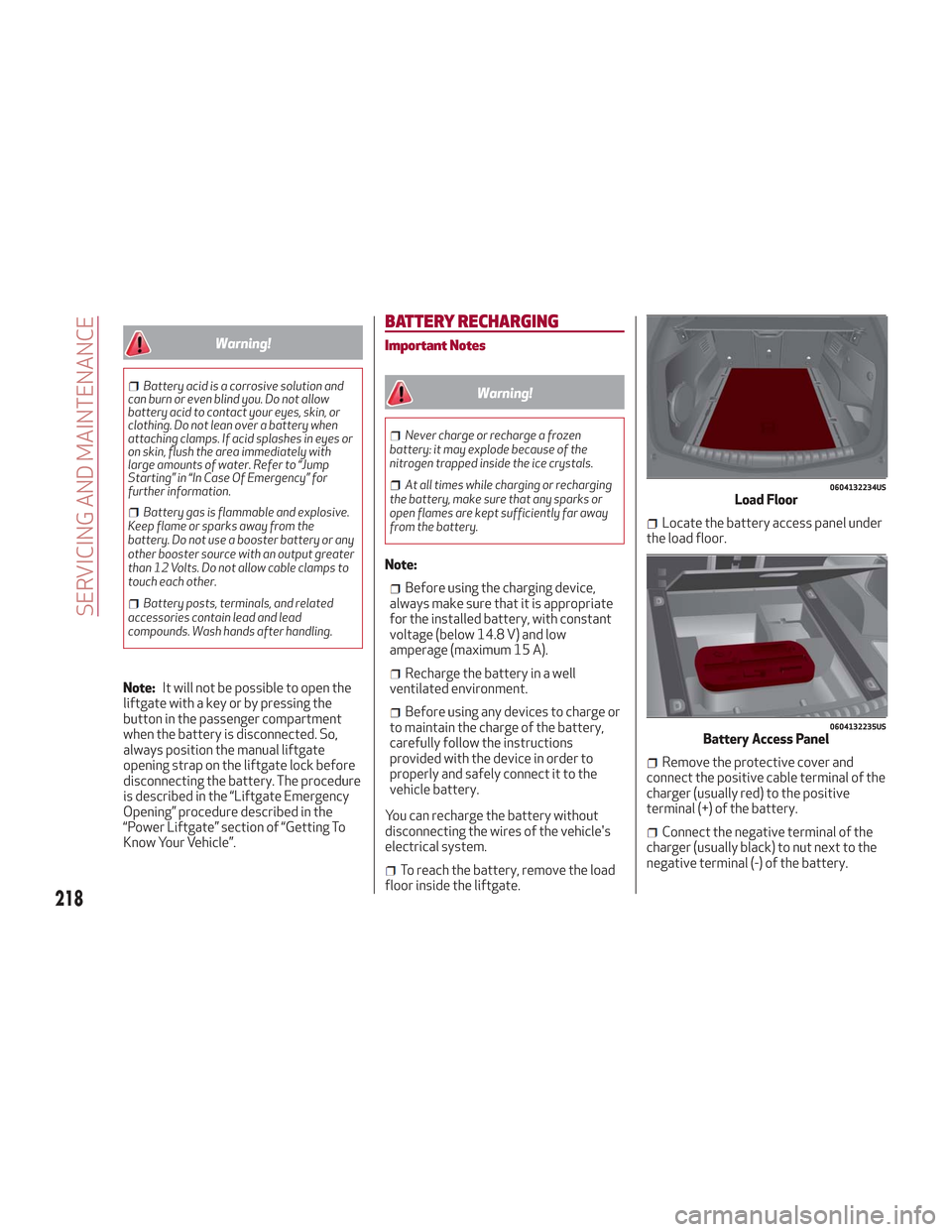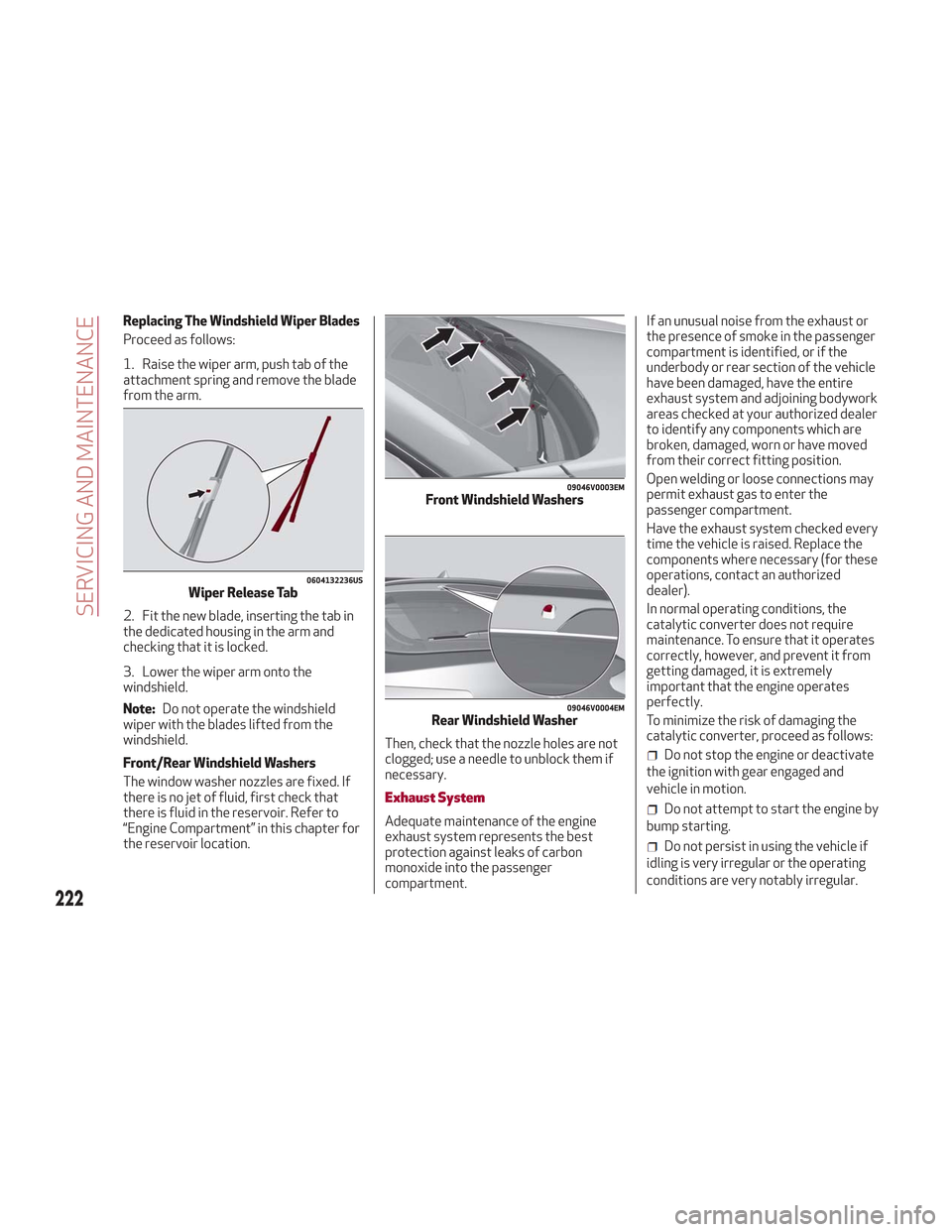2018 Alfa Romeo Stelvio lock
[x] Cancel search: lockPage 213 of 276

Heavy Usage Of The Vehicle
If the vehicle is used under one of the following conditions:
Dusty roads.
Short, repeated journeys less than 4 miles (7-8 km) at sub-zero outside temperatures.
Engine often idling or driving long distances at low speeds or long periods of inactivity.
In the event of a long period of inactivity.
The following checks must be carried out more often than indicated in the Scheduled Servicing Plan:
Check cleanliness of hood and liftgate locks, cleanliness and lubrication of linkage.
Visually inspect conditions of: engine, transmission, pipes and hoses (exhaust/fuel system/brakes) and rubber elements
(sleeves/bushes, etc.).
Check battery charge and battery fluid level (electrolyte).
Visually inspect conditions of the accessory drive belts.
Check and, if necessary, change engine oil and replace oil filter.
Check and, if necessary, replace cabin air filter.
Check and, if necessary, replace air cleaner.
Severe Duty All Models
Change Engine Oil at 4,000 miles (6,500 km) if the vehicle is operated in a dusty and off-road environment or is operated
predominately at idle or only very low engine RPM’s. This type of vehicle use is considered Severe Duty.
211
Page 214 of 276

Maintenance Plan (2.9L V6 Engine)
Thousands of miles10
20 30
40 50
60
70
80
90
100
110
120
130
140
150
Years123456789101112131415
Thousands of kilometers16
32 48
64 80
96
112
128
144
160
176
192
208
224
240
Check battery charge status with the proper instrument. ●●●●●●●●●●●●●●●
Check tire condition/wear and adjust pressure, if necessary.
Check the tire repair kit recharge condition and expiration
date. ●●●●●●●●●
●●●●●●
Check operation of lighting system (headlights, direction
indicators, hazard warning lights, trunk lid, passenger
compartment, glove compartment, instrument panel warning
lights, etc.). ●●●●●●●●●
●●●●●●
Check and, if necessary, top up fluid levels.
(1)●●●●●●●●● ●●●●●●
Check engine control system operation (via diagnostic tool). ●●●●●●●●●●●●●●●
Visually inspect conditions of: exterior bodywork, underbody
protection, pipes and hoses (exhaust, fuel system, brakes),
rubber elements (sleeves, bushes, etc.). ●●●●●●●
Check position/wear of front windshield wiper blade. ●●●●●●●●
Check operation of the windshield wiper/washer system and
adjust nozzles, if necessary. ●●●●●●●●
Check cleanliness of hood and luggage compartment locks,
cleanliness and lubrication of linkage. ●●●●●●●
(1) Top up using the fluids indicated in the “Fluids And Lubricants” section of the “Technical Specifications” chapter only after checking that the system is intact.
212
SERVICING AND MAINTENANCE
Page 220 of 276

Warning!
Battery acid is a corrosive solution and
can burn or even blind you. Do not allow
battery acid to contact your eyes, skin, or
clothing. Do not lean over a battery when
attaching clamps. If acid splashes in eyes or
on skin, flush the area immediately with
large amounts of water. Refer to “Jump
Starting” in “In Case Of Emergency” for
further information.
Battery gas is flammable and explosive.
Keep flame or sparks away from the
battery. Do not use a booster battery or any
other booster source with an output greater
than 12 Volts. Do not allow cable clamps to
touch each other.
Battery posts, terminals, and related
accessories contain lead and lead
compounds. Wash hands after handling.
Note: It will not be possible to open the
liftgate with a key or by pressing the
button in the passenger compartment
when the battery is disconnected. So,
always position the manual liftgate
opening strap on the liftgate lock before
disconnecting the battery. The procedure
is described in the “Liftgate Emergency
Opening” procedure described in the
“Power Liftgate” section of “Getting To
Know Your Vehicle”.
BATTERY RECHARGING
Important Notes
Warning!
Never charge or recharge a frozen
battery: it may explode because of the
nitrogen trapped inside the ice crystals.
At all times while charging or recharging
the battery, make sure that any sparks or
open flames are kept sufficiently far away
from the battery.
Note:
Before using the charging device,
always make sure that it is appropriate
for the installed battery, with constant
voltage (below 14.8 V) and low
amperage (maximum 15 A).
Recharge the battery in a well
ventilated environment.
Before using any devices to charge or
to maintain the charge of the battery,
carefully follow the instructions
provided with the device in order to
properly and safely connect it to the
vehicle battery.
You can recharge the battery without
disconnecting the wires of the vehicle's
electrical system.
To reach the battery, remove the load
floor inside the liftgate.
Locate the battery access panel under
the load floor.
Remove the protective cover and
connect the positive cable terminal of the
charger (usually red) to the positive
terminal (+) of the battery.
Connect the negative terminal of the
charger (usually black) to nut next to the
negative terminal (-) of the battery.
0604132234USLoad Floor
0604132235USBattery Access Panel
218
SERVICING AND MAINTENANCE
Page 222 of 276

Ensure that the oil level is within the
interval on the dipstick between the
minimum and maximum limits
(Quadrifoglio only).
Changing The Engine Oil
See the "Maintenance Plan" for the
correct servicing intervals.
Choice Of Engine Oil Type
To ensure optimal performance and
maximum protection in all operating
conditions, it is advised to use certified
engine oils. Refer to "Fluid And
Lubricants" in "Technical Specifications"
for further information.
Additives For Engine Oil
It is strongly recommended not to use
additives (other than leak detection dyes)
with the engine oil.
The engine oil is a product designed
specially for the vehicle and its
performance may be deteriorated
through the use of further additives.
Disposal Of Used Engine Oil And Filters
For the disposal of the engine oil and
filters, contact the appropriate body to
determine local regulations.
Note:Used engine oil disposed of
incorrectly may seriously harm the
environment.Engine Oil Filter
Replacing the Engine Oil Filter
The engine oil filter must be replaced
each time the engine oil is changed. It is
advised to replace it with a genuine spare
part, specifically designed for this
vehicle.
Air Filter
Replacing the Air Cleaner
See the "Maintenance Plan" for the
correct servicing intervals. It is advised to
replace it with a genuine spare part,
specifically designed for this vehicle.
Air Conditioning System Maintenance
To ensure the best possible performance,
the air conditioning system must be
checked and undergo maintenance at an
authorized dealer at the beginning of the
summer.
Caution!
Do not use chemicals to clean the air
conditioning system, since the internal
components may be damaged. This kind of
damage is not covered by warranty.
Replace The Cabin Air Filter
See the "Maintenance Plan" for the
correct servicing intervals. For cleaner
replacement, contact an authorized
dealer.
Warning!
Use only refrigerants and compressor
lubricants approved by the manufacturer for
your air conditioning system. Some
unapproved refrigerants are flammable and
can explode, injuring you. Other unapproved
refrigerants or lubricants can cause the
system to fail, requiring costly repairs. Refer
to Warranty Information Book, located in
your owner’s information kit, for further
warranty information.
Lubricating Moving Parts Of The
Bodywork
Ensure that the locks and bodywork
junction points, including components
such as the seat guides, door hinges (and
rollers), liftgate and hood are periodically
lubricated with lithium-based grease to
ensure correct, silent operation and to
protect them from rust and wear.
Thoroughly clean the components,
eliminating every trace of dirt and dust.
After lubricating, eliminate excess oil and
grease. Also pay particular attention to
the hood closing devices, to ensure
correct operation. During operations on
the hood, to be carried out with the
engine cold, also remember to check,
clean and lubricate the locking, release
and safety devices.
220
SERVICING AND MAINTENANCE
Page 223 of 276

Lubricate the external lock barrels twice
a year. Apply a small amount of
high-quality lubricant directly into the
lock barrel.
If necessary, contact your authorized
dealer as soon as possible.
Windshield Wiper
Periodically clean the windshield and rear
window and rubber profile of the
windshield wiper blades, using a sponge
or a soft cloth and a non-abrasive
detergent. This eliminates the salt or
impurities accumulated when driving.
Prolonged operation of the windshield
window wipers with dry glass may cause
the deterioration of the blades, in
addition to abrasion of the surface of the
glass. To eliminate the impurities on the
dry glass, always operate the windshield
washers.
In the event of very low outdoor
temperatures, below zero degrees,
ensure that the movement of the rubber
part in contact with the glass is not
obstructed. Use a suitable deicing
product to release it if required.
Avoid using the windshield wipers to
remove frost or ice.
Also avoid contact of the rubber profile
of the blades with petroleum derivatives
such as engine oil, gas, etc.
Warning!
Driving with worn windshield wiper blades is
a serious hazard, because visibility is
reduced in bad weather conditions.
Note:The life of the windshield wiper
blades varies according to the usage
frequency. In any case, it is advised to
replace the blades approximately once a
year. When the blades are worn, noise,
marks on the glass or streaks of water
may be noticed. In the presence of these
conditions, clean the windshield wiper
blades or, if necessary, replace them.
Raising The Windshield Wiper Blades
("Service Position" Function)
The "service position" function allows the
driver to replace the windshield wiper
blades more easily. It is also
recommended to activate this function
when it is snowing and to make it easier
to remove any dirt deposits in the area
where the blades are normally
positioned, when washing.
Note: If the windshield wipers are raised
while not in the “service position,” it is
possible to damage the hood.
Activation Of The Function
To activate this function, disable the
windshield wiper before cycling the
ignition to STOP. This function can only be activated within
two minutes of cycling the ignition to
STOP.
To activate this function, move the lever
upward for at least three seconds.
Function Deactivation
The function is deactivated if:
More than two minutes passes before
cycling the ignition to the STOP position
after having raised the lever and putting
the wipers into service position.
The ignition is cycled to the ON and the
windshield wiper control is used.
If, after using the function, the ignition is
set back to ON with the blades in a
position other than rest position (at the
base of the windshield), they will only
return to rest position following a
command given using the stalk (stalk
upwards, into unstable position) or when
a speed of 3 mph (5 km/h) is exceeded.
09046V0001EMWindshield Wiper Stalk
221
Page 224 of 276

Replacing The Windshield Wiper Blades
Proceed as follows:
1. Raise the wiper arm, push tab of the
attachment spring and remove the blade
from the arm.
2. Fit the new blade, inserting the tab in
the dedicated housing in the arm and
checking that it is locked.
3. Lower the wiper arm onto the
windshield.
Note:Do not operate the windshield
wiper with the blades lifted from the
windshield.
Front/Rear Windshield Washers
The window washer nozzles are fixed. If
there is no jet of fluid, first check that
there is fluid in the reservoir. Refer to
“Engine Compartment” in this chapter for
the reservoir location. Then, check that the nozzle holes are not
clogged; use a needle to unblock them if
necessary.
Exhaust System
Adequate maintenance of the engine
exhaust system represents the best
protection against leaks of carbon
monoxide into the passenger
compartment.If an unusual noise from the exhaust or
the presence of smoke in the passenger
compartment is identified, or if the
underbody or rear section of the vehicle
have been damaged, have the entire
exhaust system and adjoining bodywork
areas checked at your authorized dealer
to identify any components which are
broken, damaged, worn or have moved
from their correct fitting position.
Open welding or loose connections may
permit exhaust gas to enter the
passenger compartment.
Have the exhaust system checked every
time the vehicle is raised. Replace the
components where necessary (for these
operations, contact an authorized
dealer).
In normal operating conditions, the
catalytic converter does not require
maintenance. To ensure that it operates
correctly, however, and prevent it from
getting damaged, it is extremely
important that the engine operates
perfectly.
To minimize the risk of damaging the
catalytic converter, proceed as follows:
Do not stop the engine or deactivate
the ignition with gear engaged and
vehicle in motion.
Do not attempt to start the engine by
bump starting.
Do not persist in using the vehicle if
idling is very irregular or the operating
conditions are very notably irregular.
0604132236USWiper Release Tab
09046V0003EMFront Windshield Washers
09046V0004EMRear Windshield Washer
222
SERVICING AND MAINTENANCE
Page 269 of 276

INDEX
Accessories Purchased By TheOwner....................4
Active Safety Systems .........104
Active Torque Vectoring (ATV) System ................ .107
Adaptive Cruise Control .........166
Adaptive Cruise Control (ACC) (Cruise Control) ............166
Additives, Fuel ............. .256
AFS Function ................40
AirBag.................. .123
Advance Front Air Bag ........123
Air Bag Operation ...........125
Air Bag Warning Light ........123
Driver Knee Air Bag ..........126
Enhanced Accident
Response .............129,207
Event Data Recorder (EDR) .....207
Front Air Bag .............123
If A Deployment Occurs .......128
Knee Impact Bolsters ........125
Maintaining Your Air Bag System ..................... .131
Redundant Air Bag Warning Light ..................... .123
Side Air Bags .............126
Transporting Pets ..........141
Air Bag Light .............123,142
Air Bag Maintenance ...........131 Air Pressure
Tires .................. .233
Alarm (Security Alarm) ..........21
Alfa Active Suspension (AAS) .....161
Alfa DNA System .............158
Anti-Lock Braking (ABS) System . . .104
Antifreeze (Engine Coolant) ......257
Automatic Dimming Mirror ........37
Automatic Headlights ...........39
Automatic Temperature Control (ATC) ...................48
Automatic Transmission ........152
Auxiliary Driving Systems ........107
B-Pillar Location .............230
Battery ..................
.217
K
eyless Key Fob Replacement ....17
Battery Recharging ...........218
Belts, Seat ................ .142
Blind Spot Monitoring ..........107
Bodywork (Cleaning And Maintenance) .............242
Brakes .................. .250
Brake Fluid Level ...........217
Brightness, Interior Lights ........44
Bulbs, Light ............... .143
Camera, Rear .............. .179
Capacities, Fluid .............257
Carbon Monoxide Warning .......141Certification Label
............182
Changing A Flat Tire ...........225
Chart, Tire Sizing .............227
Check Engine Light (Malfunction Indicator Light) ............101
Checking Levels .............215
Checking Your Vehicle For Safety . . .141
Checks, Safety ..............141
Child Restraint ..............131
Child Restraints Booster Seats .............134
Child Restraints ............131
Child Seat Installation ........139
How To Stow An Unused ALR Seat
Belt .................. .138
Infants And Child Restraints . . . .133
LATCH Positions ...........135
Lower Anchors And Tethers For
Children ............... .135
Older Children And Child
Restraints .............. .133
Seating Positions ...........134
Clean Air Gasoline ............255
Cleaning Wheels ................ .238
Climate Control ............47,50
Close The Hood ...............57
Compact Spare Tire ...........237
Contract,
Service .............263
Page 270 of 276

Cooling SystemCoolant Capacity ...........257
Selection Of Coolant (Antifreeze) ..................... .257
Courtesy Mirror Light (Bulb Replacement) .............191
Cruise Control (Speed Control) . . . .166
Cupholder ..................67
Cupholders .................67
Customer Assistance ..........262
Daytime Running Lights ..........39
Daytime Running Lights (DRL) ......39
Defroster, Windshield ..........142
Dimensions ............... .253
Direction Indicators (Changing A Bulb) .................. .191
Disabled Vehicle Towing .........204
Door Light ..................43
Door Locks Child-Protection Door Lock —
Rear Doors ................27
Power Door Locks ...........27
Doors .....................23
Drive Train Control (DTC) System . . .104
Driving Modes ............. .158
Dynamic Steering Torque (DST) System ................ .107
Electric Park Brake ............149
Electric Remote Mirrors .........37Electric Steering Wheel Heating
.....37
Electronic Speed Control ........164
Electronic Speed Control (Cruise Control) ............. .164,166
Electronic Stability Control (ESC) System ................ .105
Emergency, In Case Of ..........198
Hazard Warning Flasher .......188
Jacking ................ .225
Jump Starting .............201
Overheating ............. .203
Towing ..............204,206
Emission Control System Maintenance ............. .101
Engine .................. .247
Block Heater ............. .149
Engine Coolant Level ........
.216
Exhaust
Gas Caution .........141
Fuel Requirements ..........255
Jump Starting .............201
Oil................... .257
Oil Selection ............. .257
Overheating ............. .203
Starting ............... .203
Engine Compartment ..........215
Engine Compartment (Washing) . . . .244
Engine Oil Level Check ............. .216
Engine Overheating ...........203 Enhanced Accident Response
Feature ..............129,207
Ethanol .................. .255
Exhaust Gas Caution ...........141
Exhaust System .............141
Exterior Lighting ............38,40
Exterior Lights ............38,143
Flashers Hazard Warning ............188
Turn Signal ............41,143
Fluid Capacities ..............257
Fluid Leaks ............... .143
Fluids And Lubricants ..........258
Forward Collision Warning (System) .110
Front Light Cluster With Main Beam Xenon Gas Discharge Headlights
(Bulb Replacement) ..........191
Front Seat Electric Heating .......31
Front Seats (Power Adjustment) ....29
Front Wipers Wiper Operation ............45
Fuel Additives ............... .256
Clean Air ............... .255
Ethanol ................ .255
Materials Added ...........256
Methanol ............... .255
Tank Capacity .............257
INDEX